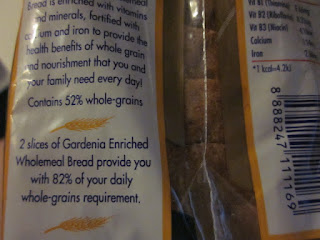I have been a shareholder of QAF for donkey years and I remember the very first time I bought some of its stock was at about 60 cents a share.
Over the years, I enjoyed free Gardenia bread with the dividends I received.
The last time I blogged about QAF was in 3Q 2018 although the last time I commented about QAF was in February 2022.
For both the blog and comments, please see:
QAF was one of my largest investments by market value at one point although it was a rather small largest investment like my investment in Sabana REIT is today.
See:
Largest investments updated 2022.
So, when was QAF one of my largest investments by market value?
It was back in 2017 when it was trading at more than $1.40 a share.
As I believed QAF was worth much more, I added to my investment back then, averaging up.
The highest price I paid was $1.42 a share.
Regular readers know I don't usually bother to calculate average prices of my positions since as an investor for income, my favorite holding period is forever and average prices aren't very meaningful to me.
As long as I feel that I have paid a fair price, it is good enough for me.
However, for this blog, I decided to calculate the average price because it would help to show how investing in bona fide income producing assets which pay meaningful dividends is less problematic even if we have paid a higher price.
My average price after averaging up was about $1.02 a share which meant that I have been nursing a paper loss since then although if I were to take into consideration the dividends received, not too bad.
The longer I stay invested, the safer it becomes.
Averaging up isn't always wrong but, of course, Mr. Market is always right.
So, through this lens, I was wrong to average up in this case.
Very cham liddat. (TmT)
Of course, regular readers know that during the COVID-19 induced bear market, I was adding to some of my investments as the dust started to settle.
Most of my war chest went to investing in the local banks and IREIT Global.
Then, later on, after the dust settled, Sabana REIT.
I had a list of businesses I would have liked to significantly increase exposure to but I didn't have unlimited firepower although I did manage to nibble at some of them.
I had to prioritize those businesses which I thought were more interesting.
The purchases involving UOB, IREIT Global and Sabana REIT were all six figure sums and were relatively large by my standards.
Mostly exhausted after those purchases, my war chest needed time to recover.
With a bigger cash pile in 2022, I decided to add to my investment in Centurion Corporation towards the end of 1Q as its stock price languished.
Then, looking around more recently, I decided to add to my investment in QAF Limited.
Back in 2021, QAF was already trading at 90c to $1 a share.
Yes, I should have bought some in 1H 2020 but hindsight is, of course, perfect and mostly useless.
Anyway, with the price of its stock languishing, I decided to add to my investment quite recently.
QAF's latest numbers shows a much stronger balance sheet which I like.
 |
| Source: QAF Limited. |
With a stronger balance sheet, QAF will not have to rely on debt too much to grow organically.
I continue to believe that QAF is a business that is recession proof and it could even benefit from an inflationary environment.
Inflation is, of course, a hot topic.
QAF had a difficult 2021 and with higher prices of wheat and energy likely to be persistent in 2022, it is easy to understand why Mr. Market is feeling somewhat pessimistic.
However, looking forward, QAF should eventually be able to pass on the increase in business costs to consumers as demand for its products should be relatively inelastic and demand could even strengthen during hard times.
Of course, I say "eventually" because if inflationary pressure should strengthen too much too quickly, things could get hairy in the shorter term.
Still, I doubt most people would stop buying their favorite loaf of quality bread just because the price has gone up by 20 or 30 cents or even a dollar.
In fact, I paid a higher price for my loaf of Gardenia low GI soft grain bread today.
Anyway, is QAF one of my largest investments now?
Even after recently adding to my investment, unless its share price goes back to $1.40 or so a share, QAF is still one of my larger smaller investments.
Of course, I could add more aggressively to my investment in QAF and make it one of my largest investments now.
However, with a war chest that is still recovering from big purchases in the last bear market, I think pacing myself is probably a good idea.
My war chest, after all, is not growing as quickly as it was able to when I was still gainfully employed so many years ago as much of my passive income is used to meet financial obligations in my retirement.
My bowling ball that sometimes cosplays as a crystal ball agrees.
Reference:
Largest investments in 2017.



































